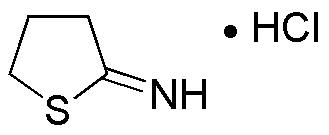2-Iminothiolane hydrochloride is widely utilized in research focused on:
- Bioconjugation: This compound is often used to create stable linkages between biomolecules, such as proteins and antibodies, enhancing their functionality in drug delivery systems.
- Protein Labeling: It serves as a valuable reagent for labeling proteins with fluorescent tags, which is essential in various imaging and diagnostic applications.
- Antibody Modification: Researchers apply it to modify antibodies for improved specificity and binding affinity, which is crucial in therapeutic applications and diagnostics.
- Cellular Studies: The compound is used in cellular assays to study protein interactions and cellular processes, providing insights into disease mechanisms.
- Drug Development: It plays a role in the development of new pharmaceuticals by facilitating the synthesis of complex molecules, streamlining the drug discovery process.
General Information
Properties
Safety and Regulations
Applications
2-Iminothiolane hydrochloride is widely utilized in research focused on:
- Bioconjugation: This compound is often used to create stable linkages between biomolecules, such as proteins and antibodies, enhancing their functionality in drug delivery systems.
- Protein Labeling: It serves as a valuable reagent for labeling proteins with fluorescent tags, which is essential in various imaging and diagnostic applications.
- Antibody Modification: Researchers apply it to modify antibodies for improved specificity and binding affinity, which is crucial in therapeutic applications and diagnostics.
- Cellular Studies: The compound is used in cellular assays to study protein interactions and cellular processes, providing insights into disease mechanisms.
- Drug Development: It plays a role in the development of new pharmaceuticals by facilitating the synthesis of complex molecules, streamlining the drug discovery process.
Documents
Safety Data Sheets (SDS)
The SDS provides comprehensive safety information on handling, storage, and disposal of the product.
Product Specification (PS)
The PS provides a comprehensive breakdown of the product’s properties, including chemical composition, physical state, purity, and storage requirements. It also details acceptable quality ranges and the product's intended applications.
Certificates of Analysis (COA)
Search for Certificates of Analysis (COA) by entering the products Lot Number. Lot and Batch Numbers can be found on a product’s label following the words ‘Lot’ or ‘Batch’.
*Catalog Number
*Lot Number
Certificates Of Origin (COO)
This COO confirms the country where the product was manufactured, and also details the materials and components used in it and whether it is derived from natural, synthetic, or other specific sources. This certificate may be required for customs, trade, and regulatory compliance.
*Catalog Number
*Lot Number
Safety Data Sheets (SDS)
The SDS provides comprehensive safety information on handling, storage, and disposal of the product.
DownloadProduct Specification (PS)
The PS provides a comprehensive breakdown of the product’s properties, including chemical composition, physical state, purity, and storage requirements. It also details acceptable quality ranges and the product's intended applications.
DownloadCertificates of Analysis (COA)
Search for Certificates of Analysis (COA) by entering the products Lot Number. Lot and Batch Numbers can be found on a product’s label following the words ‘Lot’ or ‘Batch’.
*Catalog Number
*Lot Number
Certificates Of Origin (COO)
This COO confirms the country where the product was manufactured, and also details the materials and components used in it and whether it is derived from natural, synthetic, or other specific sources. This certificate may be required for customs, trade, and regulatory compliance.

